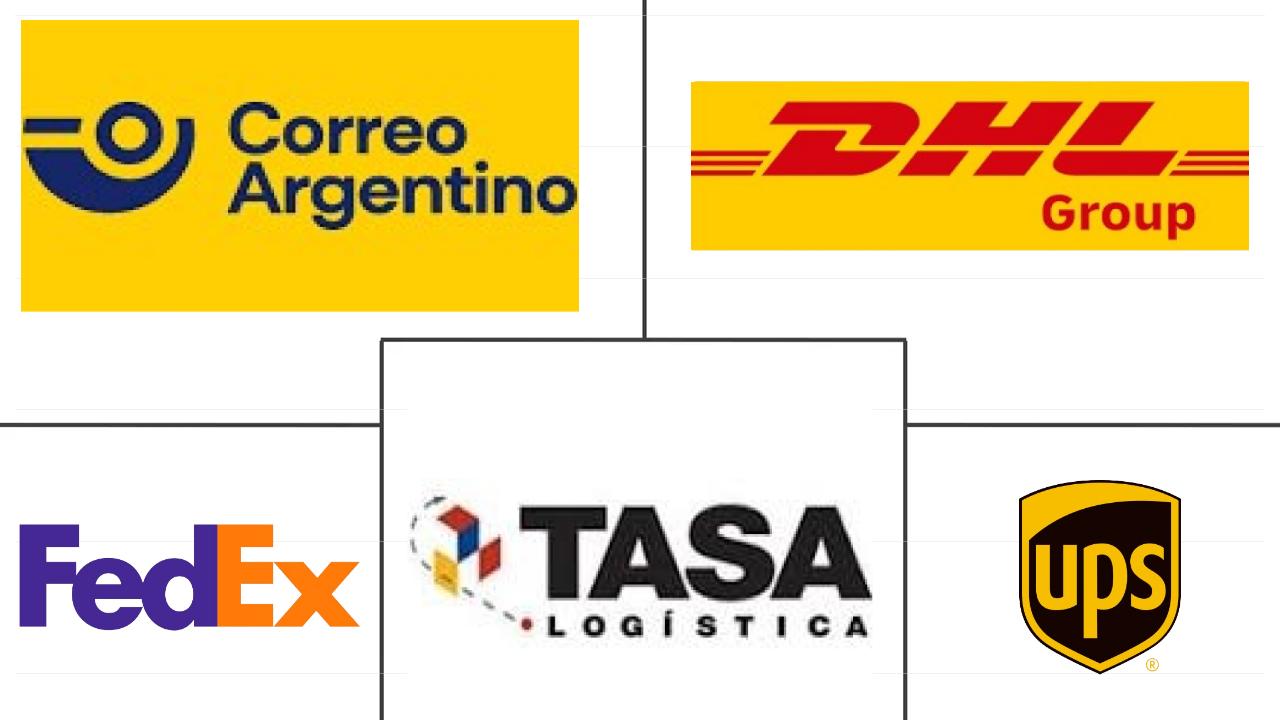Market Size of argentina courier, express, and parcel (cep) Industry
|
|
Study Period | 2017 - 2030 |
|
|
Market Size (2024) | USD 1.19 Billion |
|
|
Market Size (2030) | USD 1.71 Billion |
|
|
Largest Share by Destination | Domestic |
|
|
CAGR (2024 - 2030) | 6.27 % |
|
|
Fastest Growing by Destination | International |
Major Players |
||

|
||
|
*Disclaimer: Major Players sorted in no particular order |
Argentina Courier, Express, and Parcel (CEP) Market Analysis
The Argentina Courier, Express, and Parcel (CEP) Market size is estimated at 1.19 billion USD in 2024, and is expected to reach 1.71 billion USD by 2030, growing at a CAGR of 6.27% during the forecast period (2024-2030).
1.19 Billion
Market Size in 2024 (USD)
1.71 Billion
Market Size in 2030 (USD)
5.42 %
CAGR (2017-2023)
6.27 %
CAGR (2024-2030)
Fastest Growing Market by Speed of Delivery
7.20 %
Projected CAGR, Express, 2024-2030
Various partnerships and collaborations are facilitating large courier companies with established networks to provide express delivery services due to increasing demand.
Fastest Growing Market by Model
8.15 %
Projected CAGR, Business-to-Consumer (B2C), 2024-2030
Leading domestic and international e-commerce players are generating significant delivery demand under the B2C segment.
Largest Market by Shipment Weight
47.72 %
value share, Heavy Weight Shipments, 2023
Goods like fashion items, groceries, personal care items, and smartphones are driving demand and growth in the lightweight shipment segment.
Largest Market by End User Industry
34.91 %
value share, Manufacturing, 2023
The manufacturing sector’s growth is driving the demand for courier, express, and parcel services in the country.
First Leading Market Player
28.09 %
market share, Correo Argentino, 2022

Correo Argentino incorporated 121 sustainable vehicles to be assigned to the distribution centers of Argentina to improve last-mile delivery.
E-commerce is driving the CEP market demand generation and growth
- E-commerce has been a major driver for the domestic and international CEP market despite inflationary pressures in the country. The largest player in the Argentinian e-commerce market was mercadolibre.com.ar, with a revenue of USD 510.8 million in 2022. It was followed by adidas.com.ar and fravega.com as the second- and third-largest stores, with USD 207.1 million and USD 197.5 million, respectively. The top three stores collectively accounted for 31.5% of the top 100 online stores' revenue in Argentina. Also, beauty products are the most popular online products in Argentina, generating significant CEP demand. With e-commerce projected to reach USD 12.94 billion by 2027, the market is expected to grow significantly.
- The overall import and export volumes declined in 2020 due to the trade restrictions imposed by the government to curtail the spread of the COVID-19 virus. The imports declined by -13.78% YoY in 2020, and exports declined by -15.71% YoY in 2020. However, by 2021, the trade volumes improved significantly, and the imports experienced a growth of 49.17% YoY, and exports experienced a growth of 41.82% YoY. These factors have been a major contributor to the growing international CEP market as well.
- The largest e-commerce end user driving CEP demand in 2022 was electronics, with a share of 29.96%. It was followed by toys, hobby, and DIY with a share of 19.54% and furniture with 16.21%. Domestic and cross-border e-commerce is rising due to increasing demand. However, high inflation has negatively impacted consumers' purchasing power and spending capacities. Despite this, digital buyer penetration is expected to reach approximately 62% by 2025, and domestic and international CEP demand will be impacted significantly during the forecast period.
Argentina Courier, Express, and Parcel (CEP) Industry Segmentation
Domestic, International are covered as segments by Destination. Express, Non-Express are covered as segments by Speed Of Delivery. Business-to-Business (B2B), Business-to-Consumer (B2C), Consumer-to-Consumer (C2C) are covered as segments by Model. Heavy Weight Shipments, Light Weight Shipments, Medium Weight Shipments are covered as segments by Shipment Weight. Air, Road, Others are covered as segments by Mode Of Transport. E-Commerce, Financial Services (BFSI), Healthcare, Manufacturing, Primary Industry, Wholesale and Retail Trade (Offline), Others are covered as segments by End User Industry.
- E-commerce has been a major driver for the domestic and international CEP market despite inflationary pressures in the country. The largest player in the Argentinian e-commerce market was mercadolibre.com.ar, with a revenue of USD 510.8 million in 2022. It was followed by adidas.com.ar and fravega.com as the second- and third-largest stores, with USD 207.1 million and USD 197.5 million, respectively. The top three stores collectively accounted for 31.5% of the top 100 online stores' revenue in Argentina. Also, beauty products are the most popular online products in Argentina, generating significant CEP demand. With e-commerce projected to reach USD 12.94 billion by 2027, the market is expected to grow significantly.
- The overall import and export volumes declined in 2020 due to the trade restrictions imposed by the government to curtail the spread of the COVID-19 virus. The imports declined by -13.78% YoY in 2020, and exports declined by -15.71% YoY in 2020. However, by 2021, the trade volumes improved significantly, and the imports experienced a growth of 49.17% YoY, and exports experienced a growth of 41.82% YoY. These factors have been a major contributor to the growing international CEP market as well.
- The largest e-commerce end user driving CEP demand in 2022 was electronics, with a share of 29.96%. It was followed by toys, hobby, and DIY with a share of 19.54% and furniture with 16.21%. Domestic and cross-border e-commerce is rising due to increasing demand. However, high inflation has negatively impacted consumers' purchasing power and spending capacities. Despite this, digital buyer penetration is expected to reach approximately 62% by 2025, and domestic and international CEP demand will be impacted significantly during the forecast period.
| Destination | |
| Domestic | |
| International |
| Speed Of Delivery | |
| Express | |
| Non-Express |
| Model | |
| Business-to-Business (B2B) | |
| Business-to-Consumer (B2C) | |
| Consumer-to-Consumer (C2C) |
| Shipment Weight | |
| Heavy Weight Shipments | |
| Light Weight Shipments | |
| Medium Weight Shipments |
| Mode Of Transport | |
| Air | |
| Road | |
| Others |
| End User Industry | |
| E-Commerce | |
| Financial Services (BFSI) | |
| Healthcare | |
| Manufacturing | |
| Primary Industry | |
| Wholesale and Retail Trade (Offline) | |
| Others |
Argentina Courier, Express, and Parcel (CEP) Market Size Summary
The Argentina Courier, Express, and Parcel (CEP) market is experiencing a robust growth trajectory, driven primarily by the surge in e-commerce activities. Despite economic challenges such as high inflation, the demand for CEP services is bolstered by the increasing online shopping trends, with major players like mercadolibre.com.ar leading the charge. The market is characterized by a moderate level of consolidation, with key companies such as Correo Argentino, DHL Group, FedEx, TASA Logística, and UPS holding significant market shares. The sector's expansion is further supported by improvements in transportation infrastructure and strategic investments aimed at enhancing logistical efficiencies and connectivity.
The CEP market's growth is also influenced by the recovery of trade volumes post-COVID-19, with both imports and exports showing significant year-on-year increases. However, challenges such as fuel shortages and rising transportation costs due to global sanctions have impacted the sector's dynamics. The government's efforts to modernize transportation infrastructure, including rail and port facilities, are crucial in supporting the market's growth. Additionally, partnerships and technological advancements, such as UPS's collaboration with Google Cloud for package tracking, are expected to enhance service delivery and operational efficiency in the coming years.
Argentina Courier, Express, and Parcel (CEP) Market Size - Table of Contents
-
1. MARKET SEGMENTATION (includes Market Value in USD, Forecasts up to 2030 and analysis of growth prospects)
-
1.1 Destination
-
1.1.1 Domestic
-
1.1.2 International
-
-
1.2 Speed Of Delivery
-
1.2.1 Express
-
1.2.2 Non-Express
-
-
1.3 Model
-
1.3.1 Business-to-Business (B2B)
-
1.3.2 Business-to-Consumer (B2C)
-
1.3.3 Consumer-to-Consumer (C2C)
-
-
1.4 Shipment Weight
-
1.4.1 Heavy Weight Shipments
-
1.4.2 Light Weight Shipments
-
1.4.3 Medium Weight Shipments
-
-
1.5 Mode Of Transport
-
1.5.1 Air
-
1.5.2 Road
-
1.5.3 Others
-
-
1.6 End User Industry
-
1.6.1 E-Commerce
-
1.6.2 Financial Services (BFSI)
-
1.6.3 Healthcare
-
1.6.4 Manufacturing
-
1.6.5 Primary Industry
-
1.6.6 Wholesale and Retail Trade (Offline)
-
1.6.7 Others
-
-
Argentina Courier, Express, and Parcel (CEP) Market Size FAQs
How big is the Argentina Courier, Express, and Parcel (CEP) Market?
The Argentina Courier, Express, and Parcel (CEP) Market size is expected to reach USD 1.19 billion in 2024 and grow at a CAGR of 6.27% to reach USD 1.71 billion by 2030.
What is the current Argentina Courier, Express, and Parcel (CEP) Market size?
In 2024, the Argentina Courier, Express, and Parcel (CEP) Market size is expected to reach USD 1.19 billion.

